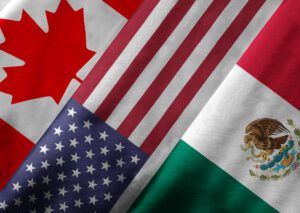U.S. Trade Policy Is at a Crossroads
|
On April 17, WITA will host a webinar titled “Biden 2.0 | Trump 2.0 – What to Expect in a Second Term” Information can be found here and below. From the end of the Second World War through the end of the Barack Obama administration, the meaning of U.S. leadership on trade was pretty clear: negotiating agreements to open markets in any country that was willing to do so. However, its definition is far from clear today. The administration of President Joe Biden has tried out approaches that put trade in the service of fighting climate change, empowering workers, discouraging monopolies, embracing U.S. allies, sanctioning Russia for its invasion of Ukraine, curbing Chinese influence, and bolstering U.S. manufacturing. But in the election year of 2024, that complex structure looks at risk of crashing from the weight of its own ambitions. U.S. trade policy was once fairly simple. Following the powerful insights of British political economist David Ricardo, countries that opened their markets to trade and investment by exporting what they produced best (and importing the rest) saw enormous—and largely shared—gains in wealth. The United States, with a huge consumer market and a slew of competitive multinational companies, considered itself a big winner from trade liberalization and encouraged agreements of every shape and size. As an added bonus, opening the U.S. market to imports helped to strengthen political alliances around the world. The job of American political leaders, therefore, was to keep negotiating trade agreements that provided ever more market opportunities for the United States and for other countries. It was a classic, and rare, win-win. One version of U.S. leadership on trade calls for restoring that old model by launching new negotiations in Asia or Latin America that would further reduce tariffs or regulatory impediments to trade. Even if that were politically possible—and with the Republican Party under Donald Trump abandoning its support for free trade it is almost certainly not—the case for restoration is weak. With tariffs already at historic lows, the gains from further market-access negotiations are likely to be small. More importantly, restoration would not tackle any of the biggest contemporary challenges: accelerating the transition to green technologies, lifting stagnant wages, containing the risks of artificial intelligences, and maintaining power balances that discourage conflicts in Europe and Asia. |
|
Why Countries Trade: A Look at Benefits and Risks
Following are excerpts from a blog post from the Open Vault Blog published by the Federal Reserve Bank of St. Louis.
Trade is an important part of the global economy, and it has grown significantly over the post-World War II era.
The significant expansion of global trade over time suggests that there are recognized benefits of trade, but there are also risks. The latter have come into more focus in recent years—for example, during the COVID-19 pandemic—as have terms like “decoupling,” “reshoring” and “friendshoring.”
I consulted Fernando Leibovici, an economic policy advisor in the St. Louis Fed’s Research Division, about the benefits and risks of trade as well as some potential ways for countries to mitigate those risks, which is where the terms mentioned above come in.
The standard view of international trade is that it is beneficial because it allows countries to specialize based on what they’re relatively good at producing, Leibovici said. Given that there are differences in how well countries produce different items, trade between two countries can lead to gains for both if they each specialize and trade what they produce…
Another benefit of trade that Leibovici mentioned is that it helps countries share risk, especially local risk. To illustrate, if a country had a major natural disaster that disrupted production of certain goods, the country may be able to obtain those goods from trading partners. In contrast, a fully closed economy—that is, one that doesn’t trade with anyone else—would be limited to what it has on its own.
Leibovici added, however, that a global shock, like the COVID-19 pandemic, would affect the country’s trading partners as well, potentially leaving them unable to help provide goods.
While trade can help with local risk management, depending on other countries to access certain goods has led to growing concerns about the potential for disruptions in recent years, particularly when it comes to “critical goods,” Leibovici said during our discussion.
He explained those concerns in the St. Louis Fed’s 2022 annual report.
“Some goods are critical to economic activity and welfare even though they account for a small portion of aggregate output and consumption,” he said in the report, noting that dependence on international trade for such critical goods is a potential source of vulnerability for the U.S. economy.
…Ultimately, it isn’t clear how big these trade risks are or how much it would cost to adjust suppliers, or even what the best way to reduce risk would be while still reaping the benefits of shared production with other countries, he said.
For example, in his December 2023 video, Leibovici discussed how the U.S. might handle semiconductor supply to deal with the possibility of shocks from abroad. “At the end of the day, there’s a trade-off between efficiency and resiliency, and the U.S. has to decide how to balance out these two forces,” he said.
|
NAFTA: 30 Years of Driving Free Trade Critics Crazy
Almost since its inception, the North American Free Trade Agreement has generated controversy far out of proportion to its economic consequences. From Ross Perot’s 1992 warning that NAFTA would create a “giant sucking sound” of jobs flowing to Mexico to Barack Obama’s (and Hillary Clinton’s) campaign trail threat to pull out of the agreement to Donald Trump’s 2016 description of it as a “disaster,” criticism of the trade deal has been a near‐constant feature of American politics.
Veracity aside, such swipes are curious. The agreement signed among Mexico, Canada, and the United States — building on a pre‐existing free trade deal between the latter two — was never going to significantly alter the United States’ economic trajectory. It just wasn’t possible. Eliminating US tariffs on imports from a single, relatively smaller country already facing very low tariffs — an average of two percent — isn’t the stuff that economic game‐changers are made of.
Perhaps, then, NAFTA is best understood as a lightning rod for criticism of globalization more broadly. Ire directed at the agreement is as much aimed at trade conceptually as it is at NAFTA itself, if not more so.
It is in this spirit that one best understands Helen Andrews’ recent critique of NAFTA in The American Conservative to mark the agreement’s 30th birthday. While Andrews, a senior editor at The American Conservative, directs several barbs at the trade deal, her main beef is the era of globalization she holds NAFTA responsible for helping usher in.
In Andrews’ telling, NAFTA was merely the first of several important free trade dominos to fall, setting off a “chain of events that allowed globalization to run free the way it did.” NAFTA’s entrance into force on January 1, 1994, she notes, was accompanied around the same time by other important milestones of expanded economic integration including the agreement creating the World Trade Organization, the formation of the European Union, and the opening of the Chunnel connecting the United Kingdom and France.
Boom, globalization was off to the races.
|
Why a USTR Report Represents Another Step Back for Digital Trade
On March 29, USTR released its 2024 National Trade Estimate Report on Foreign Trade Barriers, which can be found here. This article is a critique of provisions impacting U.S. digital exporters.
The release of annual federal agency reports are rarely given significant airtime beyond some select circles. This year, however, the release of the Congressionally-mandated National Trade Estimate Report (NTE) by the Office of the United States Trade Representative (USTR) and its decision to remove broad sets of barriers—including many significant measures harming operations of U.S. digital exporters—has sparked debate about the overall merits of identifying and challenging unfair trade practices abroad.
The issue surrounds the report that, under the 1974 Trade Act, USTR is required to publish to identify and analyze “significant barriers to, or distortions of” U.S. goods and services exports globally and, when possible, estimate the distortive impact they have on U.S. commerce. This report serves as a key part of USTR’s mandate from Congress to protect U.S. businesses from unfair treatment abroad. By chronicling the obstacles to operations and the cross-border delivery of goods and services in key foreign markets, the report lays down a marker for laws, regulations, and other policies abroad that are of concern to the United States.
Through this process, USTR signals to the countries in question that these policies are being monitored by the United States government, are seen as problematic, and that further investigation or action—including, where appropriate, formal dispute settlement— could be forthcoming. This is a crucial piece of USTR’s job assessing the global landscape for U.S. firms, targeting unfair treatment of U.S. goods and services exports, and addressing these barriers. Inclusion of a barrier in the NTE does not necessarily mean enforcement action is forthcoming from USTR, but it is an indication that a rule or regulation is hindering international trade and puts that country on notice.
The problem at the heart of this year’s NTE is that USTR has removed a sizable collection of barriers from last year’s report (466 pages’ worth) in this year’s edition (392 pages’ worth)—with a particular and concerning deprioritizing of barriers to digital trade. This is in direct contradiction to USTR’s statutory obligation to “identify and analyze acts, policies, or practices of each foreign country which constitute significant barriers to, or distortions of… United States electronic commerce” through the NTE.
More recently, this move also runs contrary to the Bipartisan Congressional Trade Priorities and Accountability Act of 2015 that directs USTR “to ensure that governments refrain from implementing trade-related measures that impede digital trade in goods and services, restrict cross-border data flows, or require local storage or processing of data.” The recent trajectory of USTR also opposes the agency’s stated goal to “[d]efend U.S. interests in digital trade and digitally delivered services” that the agency outlined in its FY2025 budget request.
|
|
|
WITA – We put the community in trade community.Information about upcoming WITA and trade community events TRADE COMMUNITY EVENTS CALENDAR |





